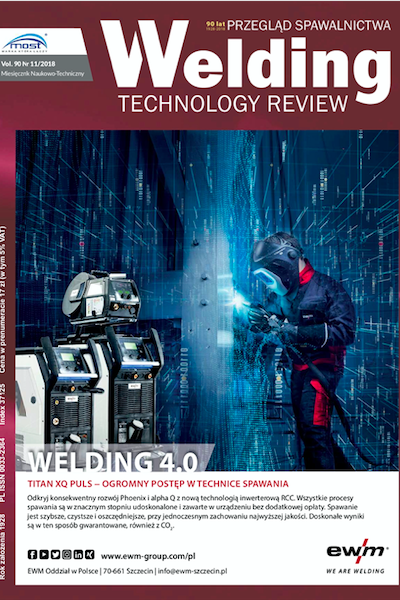Indentation testing of thin titanium coatings sprayed with cold gas
Main Article Content
Abstract
Material hardness is one of the basic parameters characterizing the propertiesof matter. In the nanohardness studies, the intendants deformation can not be neglected. Assuming the proportionality of the intenders deformation to the hardness of the material being tested, a relative hardness measurement was used in the work. Hardness measurement was carried out for fused silica, which was a reference sample. With the same nanotesting parameters, a nanoscale measurement was carried out for two samples.
Downloads
Article Details
Creative Commons CC BY 4.0 https://creativecommons.org/licenses/by/4.0/
Welding Technology Review (WTR) articles are published open access under a CC BY licence (Creative Commons Attribution 4.0 International licence). The CC BY licence is the most open licence available and considered the industry 'gold standard' for open access; it is also preferred by many funders. This licence allows readers to copy and redistribute the material in any medium or format, and to alter, transform, or build upon the material, including for commercial use, providing the original author is credited.
References
S. Błażewski, J. Mikoszewski, Pomiary twardości metali, WNT, Warszawa (1981).
D. Tabo, Proc. Phys. Soc. B (1954), 67, 249. DOI: https://doi.org/10.1088/0370-1301/67/3/310
W.F. Smith, J. Hashem, Foundations of Material Science and Engineering, McGraw-Hill (2001).
L. Dobrzański, Metaloznawstwo i obróbka cieplna stopów metali, Wydawnictwo Politechniki Śląskiej, Gliwice (1993).
W.C. Oliver, G.M. Pharr, An improved technique for determining hardness and elastic modulus using load and displacement sensing indentation experiments, Journal of Materials Research (1992), vol. 7, 1564-1583.
W.D. Nix, H. Gao, Indentation size effects in crystalline materials: A law for strain gradient plasticity, Journal of the Mechanics and Physics of Solids (1998), vol. 46(3), 411-425.
J.-H. Ahn, D. Kwon, Microchemical estimation of composite hardness using nanoindentation technigue for thin film coated system, Materials Science ang Engineering A (2000), vol. 285, 172-178.
M. Kot, Analiza właściwości mechanicznych układów powłoka-podłoże przy użyciu metody indentacji z wykorzystaniem wgłębników o różnej geometrii, Tribologia: teoria i praktyka, Po l skie Towarzystwo Tribologiczne, Instytut Technologii Eksploatacji Państwowy Instytut Badawczy (2011), 42, nr 2, 47-60.
W. Żórawski, A. Góral, M. Makrenek, S. Zimowski, Ttribological properties of plasma sprayed Al2O3-13TiO2 nanostructured coatings, Tribologia (2017), Tom: 2, 157-166. DOI: https://doi.org/10.5604/01.3001.0010.6342
P.P. Bandyopadhyay, D. Chicot, B. Venkateshwarlu, V. Racherla, X. Decoopman, J. Lesage, Mechanical properties of conventional and nano-structured plasma sprayed alumina coatings, Mechanics of Materials 53 (2012), 61-71. DOI: https://doi.org/10.1016/j.mechmat.2012.05.006
W.C. Oliver et al., Measurement of hardness and elastic modulus by instrumented indentation: Advances in understanding and refinements to methodology , J. Mater. Res. (2004), vol. 19(1). DOI: https://doi.org/10.1557/jmr.2004.19.1.3
